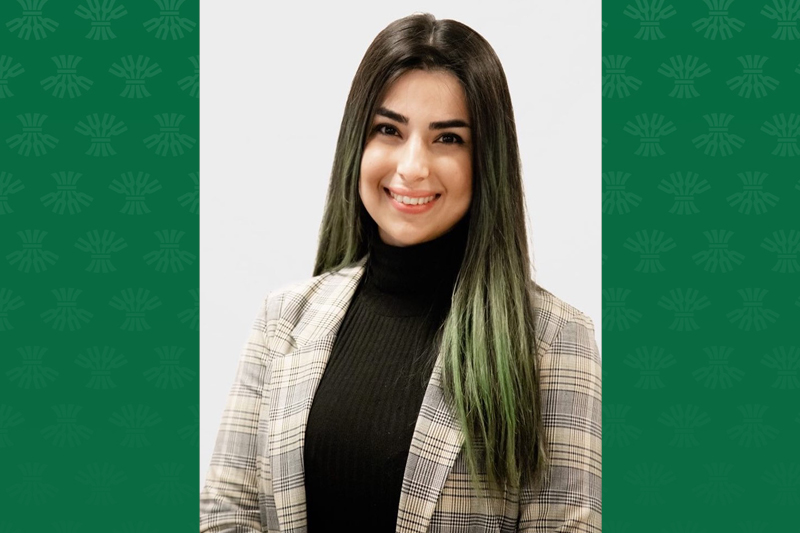
USask graduate student aims to improve quantum computing by studying qubits
Mandana Bidarvand, who is pursuing a PhD in mathematics, says enhancing medical imaging technology is one potential application of her research
By Shannon Boklaschuk
A University of Saskatchewan (USask) graduate student is studying qubits—the basic units of information in quantum computers—with the goal of improving technological devices, such as magnetic resonance imaging (MRI) machines.
“The focus of my research is studying and simulating qubit arrays—sequences of quantum bits,” said Mandana Bidarvand, who is pursuing a PhD in mathematics in USask’s College of Arts and Science.
“Many quantum-enhanced instruments and systems, such as quantum computing structures, rely on qubit arrays as a fundamental building block,” she said. “Quantum engineering exploits implementations of such structures to achieve technological goals. It will advance as a field when more is known about the characteristics of these objects, and as more flexible mathematical models and simulations are developed. Toward this goal, I am applying a unique mathematical approach first proposed by my advisor and his collaborators.”
Bidarvand is conducting her PhD research under the supervision of Dr. Artur Sowa (PhD) in the college’s Department of Mathematics and Statistics. She is also working alongside researchers at the Centre for Quantum Topology and Its Applications (quanTA), a cutting-edge USask research centre that brings together experts from mathematics, physics, chemistry, computing and other disciplines to work on all aspects of quantum materials, quantum information and computing, and quantum technology development.
Dr. Steven Rayan (PhD), quanTA’s director and a faculty member in the Department of Mathematics and Statistics, said innovative student research projects, such as that undertaken by Bidarvand, will help build Canada’s quantum future. These projects—and the activities of the centre in general—exemplify quantum innovation, one of the signature areas of research at USask.
“Quantum information is built out of qubits, which are the basic units of information in a quantum computer. Much of the mathematics developed to understand qubits works best for just a single qubit. As the number of qubits in a computer grows, it becomes more and more difficult to make numerical predictions about what is happening to the qubits. Mandana’s work, under the expert guidance of Prof. Sowa, anticipates geometric ways for understanding the collective behaviour of an extremely large number of qubits,” Rayan said.
“As scalable quantum computing is required for society to reap the full benefits of quantum computing, from complex decision-making to new approaches to drug development, Mandana’s research is especially relevant and poised to make a difference.”
Sowa said arrays of qubits “are truly fascinating objects from a mathematician’s point of view,” noting they are “massively multidimensional” and therefore inaccessible to direct numerical simulation, “which makes them appear almost mysterious.”
“On the other hand, we find that at times a little mathematical ingenuity allows a sneak peek behind that veil of inaccessibility,” he said. “One feels that in spite of the great advances of quantum physics over the span of a century, the discussion has barely started and vast riches of knowledge await to be discovered. That may be one more reason why the topic appeals to intellectually curious graduate students like Mandana.”
Bidarvand sees quantum engineering as an important application of her PhD research. She describes quantum engineering as “the art and science of constructing various devices that take advantage of the so-called quantum resources and, through that, surpass the potential of technologies available today.”
“One anticipated area of application is the medical imaging technology,” she said. “The presently known MRI machines will likely be reengineered to take advantage of quantum resources and, in this way, make them better.”
A high-achieving student, Bidarvand was previously awarded a USask Graduate Teaching Fellowship and will receive a Graduate Research Fellowship in the 2022-23 academic year. She is enjoying her time as a graduate student in the Department of Mathematics and Statistics and at quanTA, noting she is “proud to be contributing toward innovative quantum research” that supports the centre’s vision of discovering the next generation of quantum materials.
Bidarvand has long been fascinated by mathematics, particularly applied mathematics and the modelling of various types of randomness. As a master’s degree student, for example, she studied occurrences of unpredictability in relation to financial markets, risk and portfolio management, and stock and option pricing.
Studying quantum computing as a mathematics PhD student at USask was the next logical next step in Bidarvand’s educational journey.
“Quantum properties of matter are yet another source of randomness in the universe,” she said. “It is apparently quite different from the classical randomness, such as that involved in a coin toss, but there are various interconnections between them. These interconnections have captivated my interest, and my PhD project allows me to explore them in innovative ways.”
The family of quantum materials includes superconductors, which can conduct electricity with zero loss or resistance. Other quantum materials demonstrate similarly remarkable electrical or magnetic qualities and hold promise for many new technological advances.
That means the research possibilities are limitless for graduate students like Bidarvand.
“We are discovering completely new and effective mathematical approaches to problems that have seemed hopelessly difficult and only accessible via certain traditional approaches,” she said. “There comes a realization that in spite of all the results and expertise scientists have amassed there is still so much room for discovery. This is quite amazing in itself.”

